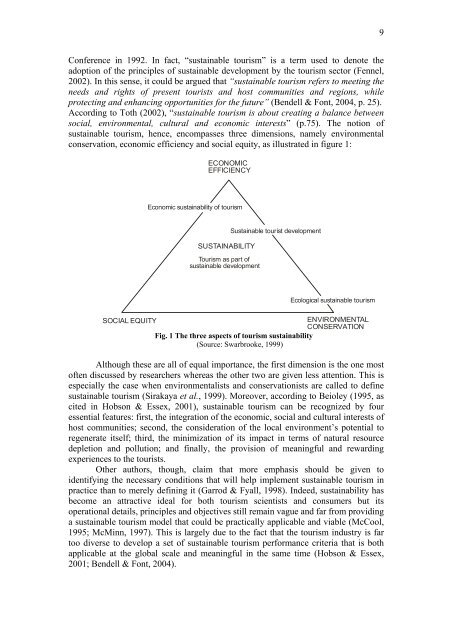9Conference in 1992. In fact, “sustainable tourism” is a term used to denote theadoption <strong>of</strong> the principles <strong>of</strong> sustainable <strong>development</strong> by the tourism sector (Fennel,2002). In this sense, it could be argued that “sustainable tourism refers to meeting theneeds and rights <strong>of</strong> present tourists and host communities and regions, whileprotecting and enhancing opportunities for the future” (Bendell & Font, 2004, p. 25).According to Toth (2002), “sustainable tourism is about creating a balance betweensocial, environmental, cultural and economic interests” (p.75). The notion <strong>of</strong>sustainable tourism, hence, encompasses three dimensions, namely environmentalconservation, economic efficiency and social equity, as illustrated in figure 1:ECONOMICEFFICIENCYEconomic sustainability <strong>of</strong> tourismSUSTAINABILITYTourism as part <strong>of</strong>sustainable <strong>development</strong>Sustainable tourist <strong>development</strong>Ecological sustainable tourismSOCIAL EQUITYENVIRONMENTALCONSERVATIONFig. 1 The three aspects <strong>of</strong> tourism sustainability(Source: Swarbrooke, 1999)Although these are all <strong>of</strong> equal importance, the first dimension is the one most<strong>of</strong>ten discussed by researchers whereas the other two are given less attention. This isespecially the case when environmentalists and conservationists are called to definesustainable tourism (Sirakaya et al., 1999). Moreover, according to Beioley (1995, ascited in Hobson & Essex, 2001), sustainable tourism can be recognized by fouressential features: first, the integration <strong>of</strong> the economic, social and cultural interests <strong>of</strong>host communities; second, the consideration <strong>of</strong> the local environment’s potential toregenerate itself; third, the minimization <strong>of</strong> its impact in terms <strong>of</strong> natural resourcedepletion and pollution; and finally, the provision <strong>of</strong> meaningful and rewardingexperiences to the tourists.Other authors, though, claim that more emphasis should be given toidentifying the necessary conditions that will help implement sustainable tourism inpractice than to merely defining it (Garrod & Fyall, 1998). Indeed, sustainability hasbecome an attractive ideal for both tourism scientists and consumers but itsoperational details, principles and objectives still remain vague and far from providinga sustainable tourism model that could be practically applicable and viable (McCool,1995; McMinn, 1997). This is largely due to the fact that the tourism industry is fartoo diverse to develop a set <strong>of</strong> sustainable tourism performance criteria that is bothapplicable at the global scale and meaningful in the same time (Hobson & Essex,2001; Bendell & Font, 2004).
10Many scholars have also attempted to define <strong>ecotourism</strong>, which explains thelarge number <strong>of</strong> definitions given by different scholars so far. In earlier years therehas been some uncertainty and confusion regarding both the definition <strong>of</strong> <strong>ecotourism</strong>and its fundamental principles (Diamantis, 1998). Some scholars contend that thisconfusion in defining <strong>ecotourism</strong> and its principles with accuracy is an importantlimiting factor for the growth <strong>of</strong> the <strong>ecotourism</strong> industry on the global level (Herbig &O’Hara, 1997). Perhaps, the most quoted definition <strong>of</strong> <strong>ecotourism</strong> is the one that wasprovided by Ceballos – Lascuráin in 1987 (as quoted in Diamantis, 2004, p.5):“Ecotourism is traveling to relatively undisturbed or uncontaminated natural areaswith the specific objective <strong>of</strong> studying, admiring and enjoying the scenery and its wildplants and animals, as well as any existing cultural manifestations (both past andpresent) found in these areas”. In addition, Wight (1993) has described <strong>ecotourism</strong> as“the tourism activities that are conducted in harmony with nature, as opposed to moretraditional, mass tourism activities” (as quoted in Hawkins & Khan, 1998, p.191).Another widely accepted definition <strong>of</strong> <strong>ecotourism</strong> is also the following: “Ecotourismis responsible travel to natural areas that conserves the environment and sustains thewell-being <strong>of</strong> local people” (The International Ecotourism Society Website, consultedon 3/11/2004). Finally, the Worldwide Fund for Nature (WWF) has provided adefinition for <strong>ecotourism</strong> that is developed within or near protected areas:“Ecotourism is tourism within nature that, in contrast with mass tourism, does notexceed the carrying capacity 6 <strong>of</strong> the area in which it is developed, while at the sametime promotes the conservation <strong>of</strong> natural and cultural environment and helps sustainsocial cohesion” (WWF-Greece, 2000, p.12).Although there are some differences in the way various scholars perceive themeaning <strong>of</strong> <strong>ecotourism</strong>, most researchers generally agree that <strong>ecotourism</strong> has threemain pillars, namely it is “nature-<strong>based</strong>, environmentally educated and sustainablymanaged” (Blamey, 2001, p.6). In addition, a feature that is common in mostdefinitions <strong>of</strong> <strong>ecotourism</strong> is that it encompasses both a strong commitment to thenatural environment and a sense <strong>of</strong> social responsibility towards host communities. Inthis sense, <strong>ecotourism</strong> relies on the wise management and controlled use <strong>of</strong> naturaland cultural resources. It also enhances the interaction between people (tourists aswell as local inhabitants) and the natural environment and encourages the cooperationbetween visitors and locals for nature conservation purposes (Sirakaya et al., 1999).However, there is an ongoing debate within the academic <strong>community</strong> on whatconstitutes the fundamental target <strong>of</strong> <strong>ecotourism</strong>. According to Orams (1995), forinstance, the main goal <strong>of</strong> <strong>ecotourism</strong> should be prompting tourists to become activecontributors to the health and viability <strong>of</strong> the natural environment they visit, instead <strong>of</strong>simply mitigating their adverse environmental impact. Scheyvens (1999), on the otherhand, claims that the principal aim <strong>of</strong> <strong>ecotourism</strong> should be the empowerment <strong>of</strong> hostcommunities, whereas some others consider the contribution <strong>of</strong> <strong>ecotourism</strong> tobiodiversity conservation to be the most crucial element <strong>of</strong> all (Brandon & Margoluis,1996).Regardless <strong>of</strong> the definition that is adopted, the fact is that <strong>ecotourism</strong> hasgenerated a great deal <strong>of</strong> interest within the academic <strong>community</strong>, as well as amongthe consumers (Fennel, 2002). This, according to some scholars, reflects the growingconcern <strong>of</strong> tourists all around the world about the natural environment as they becomeincreasingly aware <strong>of</strong> the heavy environmental impacts generated by the traditional6 By the term “carrying capacity” is generally implied “the existence <strong>of</strong> fixed and determinable limitsto <strong>development</strong> and that if one stays below those threshold levels no changes or deterioration willoccur” (Murphy, 1998, pp. 180-181).
















